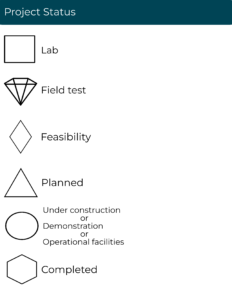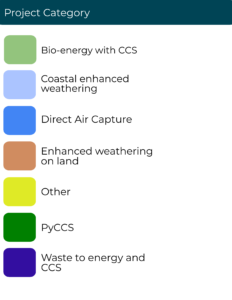Negative Emissions platform CDR Atlas
The Negative Emissions Platform Carbon Dioxide Removal Atlas is an ongoing research project, to map companies and projects that are active in the field of atmospheric and biogenic carbon removal with permanent storage.
Methodology
2. Source of CO2 and Capture method
The second step was to filter all the companies/projects based on their capture method. Only companies/projects that:
- clearly indicated their method of capture and,
- their source of CO₂ was from atmospheric or biogenic CO₂, went onto the next round.
After the first round of filtering the companies/projects, we assigned the selected companies/projects to one of the following capture categories:
- Bio-energy with CCS
- Coastal enhance weathering
- Direct Air Capture
- Enhance weathering on land
- PyCCS
- Waste to Energy with CCS
Companies/projects that did not indicate how they capture CO₂ or the source of CO₂, were discarded.
1. Collection of companies and projects
The primary purpose of the CDR Atlas is to provide an overview of companies and projects active in the field of CDR with durable long-term storage. The level of engagement can range from lab-testing new removal techniques, to one-off demonstration projects built to provide qualitative and quantitative case data, thereby furthering our understanding of methods and their potential. Because the field of CDR is vast and heterogeneous, the first step in our process was to cast a wide net and collect information on as many companies and projects active in the field. There are currently different data sources available, providing to some degree and scope information on CDR companies and projects. They include the following, for example:
Stripe, Shopify, CarbonPlan, Carbon 180
After consulting the above sources, we conducted desk research to capture companies/projects not included in the above datasets. This was especially relevant for biochar, BECCS, and Waste-to-Energy with CCS.
During this round of information gathering, the only criteria was for the captured CO₂ not to be from a point-source but atmospheric or biogenic CO₂.
3. Durable/permanent storage
The third step was to filter projects and companies based on storage duration. For the purpose of the Atlas, we only selected companies/projects with storage potential of 100+ years. Including this filter dramatically narrowed the list of potential companies/projects. After the third round of filtering, we assigned the selected companies/projects to one of the following storage categories:
- Bio-oil geologic injection
- Biochar
- Carbon utilisation
- Carbonated building materials
- Deep-sea storage
- Geological injection
- Mineralisation
- Mix
- Sub-surface mineralisation
- Unknown
Companies/projects with storage duration options of under 100 years are discarded. For some companies/projects, due to the status of the project (i.e. lab phase, field test, and demonstration plant), it was not easy to ascertain how they planned to store the captured CO₂. Secondly, we include carbon utilisation and carbonated building materials as storage methods. Both utilisation methods can safely store carbon for extended periods (100+ years).
4. Project status
The fourth and final filter is related to the current status of projects. We aim to be as representative as possible of what is happening in the CDR landscape. Therefore, we only include companies concretely testing or developing methods and projects currently in or past the feasibility phase. We exclude companies and projects that only mention CDR as part of their future roadmap without a clear strategy of how this will unfold or the resources to implement the roadmap.
Biochar companies/projects
We took a different approach for biochar producing companies/projects. Companies and projects with PyCCS as their capture method and biochar as their storage method, form part of a European Biochar Industry market report. Therefore, the companies and projects presented in the CDR Atlas should be seen as a representation of the current biochar market and not an exhaustive list of companies and projects. Due to the sensitive nature around capacity, the company/project capacity number was aggregated to a country/region level.
The interactive CDR Atlas is an ongoing project to gather and showcase projects and companies active in the field of atmospheric and biogenic carbon removal with durable/permanent storage. Our approach to selecting and adding the different companies and projects is explained in more detail in the methodology section. Please note that we used publicly available information and did our best to describe and classify companies and projects accurately. If, however, we made a mistake, or you would like your company to be added to the Atlas, please get in contact with us via info@negative-emissions.org



